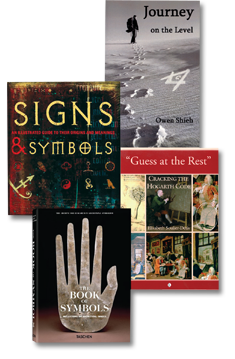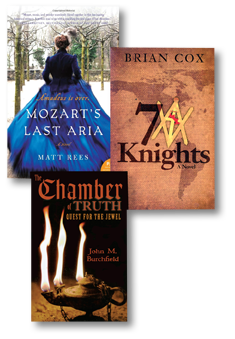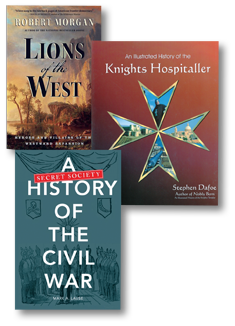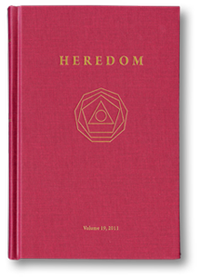James T. Tresner II, 33°
Book Review Editor
Talk about an embarrassment of riches! There is much on offer this month, on a wide variety of topics. Wherefore, without further ado.…
Davis, Robert G., 33°, G.C., Editor, Heredom: The Transactions of the Scottish Rite Research Society, Volume 19, Washington, D.C.: The Scottish Rite Research Society, 2011, hardbound, 303 Pages, illustrations, sent free to members of the Research Society. Annual membership is $52 for which you get Heredom, four issues of The Plumbline, and an annual bonus. To join online visit ScottishRite.org/about/masonic-education/srrs, or call 1-800-SRMASON (776-2766), ext 132.
Hold on to your hat, cap, chapeau, or fez, Brethren; this issue is quite a ride! The eight essays cover a lot of ground. — “Masculinity, Consumption, & the Transformation of Scottish Rite Freemasonry in Turn-of-the-Century U.S.A.” by Many Ann Clawson, Ph.D. — “Influences on the Theme of Individual and Civic Improvement in the Scottish Rite” by Daniel P. Brown, 32° — “Through the Lens of Freemasonry: Influences of Esoteric Thought on Beethoven and His Works” by Brian S. Gaona — “The Lymm Freemasons: A New Insight into Transition-Era Freemasonry” by David Harrison, M.M. — “Hannah Mather Crocker: Patriot, Founding Mother, Freemason” by Karen Kidd — “A Return to the Traditional Lodge Model” by Pierre G. “Pete” Normand, Jr., 33° — “The Role of Zerubbabel and His Temple Building Work in Scottish Rite Freemasonry” by Mark C. Phillips, 32° — “The Masonic Influence of Henry Fowle of Boston” by Richard W. Van Doren, 33°, and Michael S. Kaulback, 32°.
It’s probably cheating (I’d like to write a page on each of these articles) but the best short description I can give is to quote Brother Davis in his introductory message in the book.
Dr. Mary Ann Clawson offers our readers her academic investigation into the cultural and social considerations which influenced the Scottish Rite to move its venues from the lodge to the theatre setting at the turn of the nineteenth century. This essay is followed with a brilliant interpretation by Daniel Brown, 32°,that the mystical and magical thought in popular literature like Augustine’s City of God and Machiavelli’s The Prince and Discourses may have influenced some of the major archetypal images later developed in the Scottish Rite degrees.
Professor Brian Gaona provides us with a tantalizing hypothesis that the great composer Beethoven may have very much been in tune with the esoteric thought of his many Masonic associates. The editor regrets that the overall length of Dr. Gaona’s dissertation forced a cut of an esoteric interpretation of two of Beethoven’s last concerti. Gaona gives us a new insight into the life and relationships of this eccentric composer. Professor David Harrison follows with an interesting historical review of the wills, letters, and papers of operative masons in the Chesire village of Lymm, located outside the ancient market town of Warrington; the results of which suggest that speculative masons were entering the fraternity earlier than the 1640s. Harrison provides the reader with additional evidence in favor of the transition theory of Masonic origins.
Karen Kidd, a member of the Order of American Co-Masonry, writes of the possible initiation of feminist Hannah Mather Crocker, an early women’s rights activist, into one of the oldest masculine lodges in America, the famous St. Andrews Lodge of Boston. Our own research society board member, Pete Normand, 33°, then brings us back into the very contemporary setting of the traditional observance lodge movement, with an overview of its beginnings in the 1990s, the growing popularity of this type of lodge experience among young men entering the fraternity today, and the growing acceptance among grand lodge leaders in embracing earlier European traditions of Freemasonry within the American culture.
Finally, our 2011 volume includes another fine essay by Mark Phillips, 32°, who has been busy in Guthrie’s College of the Consistory writing about the major themes of the Rite. We conclude Volume 19 with Brothers Richard Van Doren, 33°, and Michael Kaulback, 32° sharing their research on the life of Boston’s Henry Fowle, one of the early students of Thomas Smith Webb and a nineteenth-century promoter of standardizing both the Blue Lodge and the York Rite rituals in America.
Shieh, Owen, 32°, Journey on the Level, Charleston, S.C.: Owen Shieh, 2011, softbound, 170 pages, ISBN 13:978-0615452883, cover price $14.95, available on the Internet, new and used, from about $12.

Wow, I wish I could have written this book. And I mean that in both senses; I wish I had it to my credit as an author, and I wish I thought I had the insight and ability to write it. Brother Shieh has produced that rare book that I can strongly advise every Mason to read, and especially to give to every young Mason you know who is starting his Masonic journey. The premise is so simple: how does a man in today’s world actually use in daily life what Masonry teaches? What are 21st century meanings for our ancient symbols? His answers are good, practical, thoughtful, and come from experience.
In a sense, these words describe Brother Shieh’s credo: “Surely, Freemasonry is much more than just history and tradition. The greatest reward of being a Mason is to look into the eyes of a fellow brother and know that there exists a mutual trust and understanding that cannot be expressed with words. We all have friends at work, friends at school, friend who play sports with us, and friends with whom we hang out on the weekends. But to have friends who explore the essence of life with us and commit to such an adventure—indeed, they are rare gifts.” He doesn’t preach, he encourages, but if there were ever a book on “practical Masonry,” this is it. One of the best books I’ve read in many a year.
Now two very good new books on general symbolism (not specifically Masonic symbolism). These books are both beautifully printed and very well written. I’d encourage you to have both in your library.
Wilkinson, Kathryn (project editor) Signs and Symbols: An Illustrated Guide to their Origins and Meanings, New York: Dorling Kindersley Limited, hardcover, 2008, 352 pages, very heavily and beautifully illustrated, ISBN 13: 978-0-7566-3393-6, available on the Internet from about $17.
The book has received great critical acclaim, and it is not surprising. The first section of the book looks at the sources of symbols, such things as basic shapes, colors, the world of nature, numbers, etc. The second section relates the symbols in the context of religions, mythologies, life experience, symbol systems, and culture. It’s fun just to browse the pages, and you end up learning a lot in the process.
Ronnberg, Ami (editor-in-chief), The Book of Symbols: Reflections on Archetypal Images, Colone, Germany: Taschen Books, 2010, hardcover, heavily and beautifully illustrated, thumb-indexed, 5 bound-in ribbon markers, 810 pages, ISBN 13: 978-3-8365-1448-4. Cover price $39.95, available on the Internet, new and used, from about $24.
A very different, if equally well produced and useful book. The book presents excellent essays from world experts in the symbols and give many outstanding examples of them. These two books work well together.
Soulier-Detis, Elisabeth, Guess at the Rest: Cracking the Hogarth Code, Cambridge, UK: Lutterworth Press. 2010, hardcover, heavily illustrated, 240 pages, ISBN 13: 978-071-889-215-9, available new and used on the Internet from about $60.
Professor Soulier-Detis, recently retired from the Paul Valery University and as General Editor of The European Spectator, has a long-standing fascination with 18th Century British art. She has done a fascinating job in this book. For those not familiar with Hogarth, he was a very important painter and printmaker, social critic and satirist, who lived from 1697 to 1764. He was an active Freemason and Masonry appears in many of his works. (He didn’t spare his beloved Fraternity criticism—one of his most famous prints shows a Tyler helping the Master of the Lodge get home at night, when the latter has obviously had more than enough to drink.) To quote from the book description: “The classical and Biblical references, whose ambiguity and apparent paradoxical relation with the eighteenth-century situations depicted have often been underlined, gain coherence and unity when they are analyzed in the symbolic framework of Freemasonry and alchemy Hogarth was busy both using and concealing in his prints.” It’s an expensive book, but it is impressive in its printing and fascinating in its discussion.
I enjoy buckling a little swash from time to time, and the next three novels, each very different, do that well. Freemasonry plays an important part in each.
Rees, Matt, Mozart’s Last Aria, New York: Harper Perennial, Publishers, 2011, 336 pages, paperbound, ISBN 13: 978-0062015869, Cover Price $14.99, available on the Internet new and used from about $5.00

I’ve lost the note with the name of the Brother who recommended this, so I can’t give him credit, but it was a good recommendation. Rees, former Jerusalem Bureau Chief for Time Magazine, is an award-winning author of crime and mystery novels. In this case he has taken the story of Mozart’s death and told the story from the viewpoint of Nannerl—Mozart’s sister and a musical prodigy in her own right. I can’t tell you much about it, it is a mystery, after all, but I can tell you that the book has won strong critical acclaim. It will hold your interest. In an afterword, Rees tells us how the book follows the structure of the A minor piano sonata (K 310), which I found very interesting. Also, as an aside, the book feels good in the hand—unusual for a paperback. You certainly don’t have to be a Mason to enjoy the book, but it does make it an even richer experience.
Burchfield, John, 32°, The Chamber of Truth —Quest for the Jewel Dallas: The P3 Press, 2010, softbound, ISBN 13: 978-1-933651-81-1 available at www.JohnBurchfieldBooks.com for $14.95 + S&H (if requested, the author will sign and personalize the book); kindle edition available for $4.98.
Brother Burchfield brings a long career in law enforcement to the book, and it shows in the attention to details, but essentially this the sort of story which, in the days of glory, was called a “ripping yarn.” Good and evil clash, and, to quote one of the reviews, “Burchfield masterfully constructs a world steeped in ancient religion, the society of Freemasons, and the inner workings of the City of Jerusalem. Spoken through the voice of a member of the society, The Chamber of Truth offers an unprecedented glimpse of the true power of the principles and belief system of the Freemasons.”
I put it in the stack of books I plan on reading again in a few months. It’s a fun and gripping read, and well worth experiencing more than once.
Cox, Brian, 32°, 7 Knights, Mustang, OK: Tate Publishing, 2011, softbound, 216 pages, available at the website www.tatepublishing.com/bookstore for $16.99 + S&H, or if you wish you can purchase it directly from Brother Cox at [email protected] if you want it signed and personalized. A kindle edition available for $7.99 ISBN 13: 978-1-61777-544-4
There is talk of turning the book into a movie, and it would be an exciting one. Brother Cox has an interesting writing style, highly visual without using the usual visual techniques. At times you are not certain if you are responding to visual or emotional imagery, but whatever it is, it works. I don’t want to give away a plot, of course, but this much is available on the book site. “. . . Walt is plunged into the fight of his life when terrorists begin killing off the hidden network of Templar Knights, led by seven vital figures. Walt’s grandfather, newly-elected U.S. President Preston Tyler, one of the seven, holds the key to protecting the knights. . .” And there is a great sequence in which the President of the United States, his grandson, and a entourage of motorcycle riders are taking it on the lam, hiding out from both terrorists and the Secret Service. The book is great fun and if you like a bit of daring-do, this daring-does it.
And now to history.
Lause, Mark A. A Secret Society History of the Civil War, Urbana, IL: University of Illinois Press, 2011, hardcover, 232 pages, illustrations, ISBN 13: 978-0-252-03655-2, cover price $35.00, available in the Internet, new and used, from about $16.00

The aforementioned Bro. Robert G. Davis twigged me to this book, for which I am grateful. A full professor of history at the University of Cincinnati, Dr. Lause has traced the importance of secret societies, including but certainly not limited to Freemasonry, in the events leading up to the Civil War and afterward. The critics have spoken very highly of the book, suggesting that Lause has brought a new and important perspective to the study of Civil War history.
“This exceptional study encompasses both white and African American secret society involvement. Revealing the black fraternal experience in antebellum America as well as the clandestine operations that provided assistance to escaped slaves via the Underground Railroad. Unraveling these pervasive and extensive networks of power and influence, A Secret Society History of the Civil War demonstrates that antebellum secret societies played a greater role in affecting Civil War-era politics than has been previously acknowledged.”
Freemasonry is not the biggest player in the events, but it is not insignificant. History and Civil War buffs will enjoy this book.
Morgan, Robert, Lions of the West: Heroes and Villains of the Westward Expansion, Chapel Hill, NC: Shanon Ravenel Books, 2011, hardcover, 496 pages, maps and illustrations, ISBN 13: 978-1-56512-626-8, cover price $29.95, available new and used on the Internet from about $7.00
Thanks to M.W. Richard Fletcher, P.G.M. of Vermont for alerting me to this book! Morgan, a well-established and respect author in several fields, tells the fascinating stories of Thomas Jefferson, Andrew Jackson, John Chapman, David Crockett, Sam Houston, James K. Polk, Winfield Scott, Kit Carson, Nicholas Trist, and John Quincy Adams. There are several references to Freemasonry and the Masonic membership of some of the men. This is the story of America’s Manifest Destiny, told through the lives of the men who made it a reality. The author provides remarkable insight into the lives of these men, and while the book reads like a novel, it is not fictionalized. The Boston Globe wrote: “Robert Morgan’s latest work is a tour-de-force of historical concision, combining prodigious research and adroit synthesis.” It is all of that.
This would be a good book to give to your local library when you have finished enjoying it.
Dafoe, Stephen, An Illustrated History of the Knights Hospitaller, Hersham, Surrey, UK: Ian Allen Publishing, 2010, hardbound, 160 pages, many illustrations, most in color, cover price $32.95, available new and used on the Internet from about $20.00, ISBN 13: 978-07110-3497-6
Brother Dafoe is no stranger to Masonic readers, having produced many highly-regarded books and scholarly articles dealing with the history of the Fraternity. Most Masons are more familiar with the Knights Templar (on which Brother Dafoe has also written), but the Knights Hospitaller are less well known. Yet their interaction with the Knights Templar and with the history of the Crusades made them very important players in the world of the Middle Ages.
The book, which is a visual delight as well as an educational one, traces their history and places it in the context of a world looking for some form of certainty. With all the economic and political tensions of 2012, it is easy to forget just how stable our lives really are by comparison to those times. This is a good and informative read, and a true pleasure of a book.







